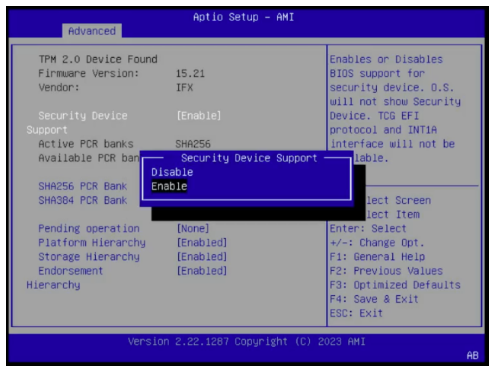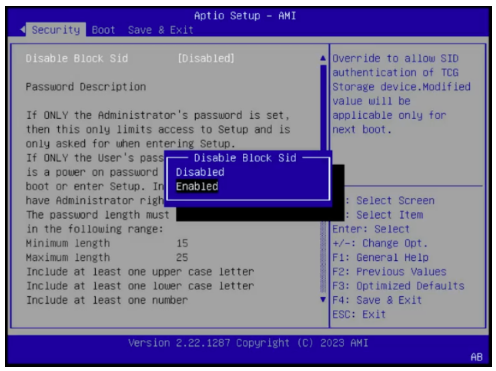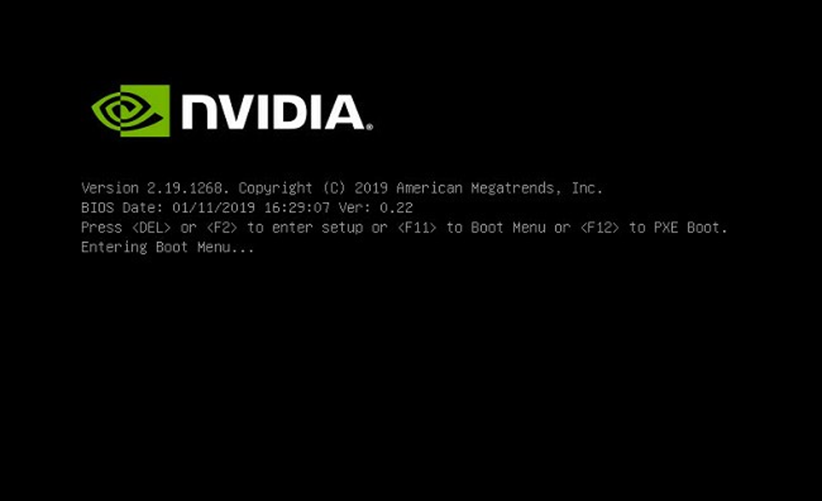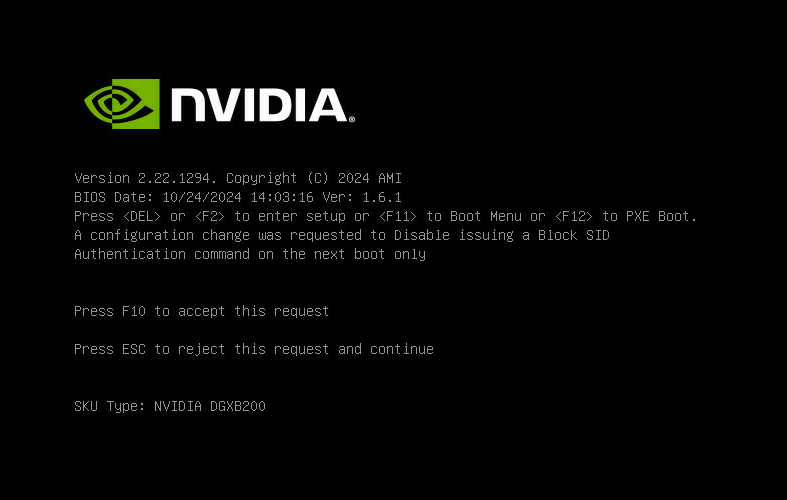Managing Self-Encrypting Drives#
The NVIDIA DGX OS software supports the ability to manage self-encrypting drives (SEDs), including setting an Authentication Key for locking and unlocking the drives on NVIDIA DGX B300, DGX B200, DGX H100/H200, DGX A100, and DGX A800 platforms.
You can manage only the SED data drives. The software cannot be used to manage OS drives even if they are SED-capable.
Overview#
The SED management software is in the nv-disk-encrypt package.
The software supports the following configurations:
NVIDIA DGX B300, DGX B200, DGX H100/H200, DGX A100, and DGX A800 systems where all data drives are self-encrypting drives.
Only SEDs used as data drives are supported.
The software will not manage SEDs that are OS drives.
The software provides the following functionality:
Identifies eligible drives on the system.
Allows you to you assign Authentication Keys (passwords) for each SED as part of the initialization process.
Alternatively, the software can generate random passwords for each drive.
The passwords are stored in a password-protected vault on the system.
Once initialized, SEDs are locked upon power loss, such as a system shutdown or drive removal.
Locked drives get unlocked after power is restored and the root file system is mounted.
Provides functionality to export the vault.
Provides functionality for erasing the drives.
Provides the ability to revert the initialization.
Installing the Software#
Use the package manager to install the nv-disk-encrypt package and, optionally, the TPM2 tools package, and reboot the system.
You need the TPM tools package if you plan to use the TPM2 to store security keys.
Update the packages.
sudo apt update
Install
nv-disk-encrypt.sudo apt install -y nv-disk-encrypt
(Optional) Install the TPM tools package.
For DGX A100, DGX Station A100, or DGX H100/H200, install the
tpm2-toolspackage.
sudo apt install -y tpm2-tools
For DGX-2, install the
tpm-toolspackage.
sudo apt install -y tpm-tools
Reboot.
sudo reboot
If you plan to use TPM2, enable it. Refer to Configuring Trusted Computing for more information.
Configuring Trusted Computing#
Here is some information about the controls that are required to configure Trusted Computing (TC).
The DGX system BIOS provides setup controls for configuring the following TC features:
Trusted Platform Module
NVIDIA DGX B300, DGX B200, DGX H100/H200, DGX A100, and DGX A800 platforms incorporate Trusted Platform Module 2.0 (TPM 2.0). These modules can be enabled from the system BIOS and used in conjunction with the
nv-disk-encrypttool. After being enabled, thenv-disk-encrypttool uses the TPM for encryption and stores the vault and SED authentication keys on the TPM instead of on the file system. Using the TPM is preferred because this allows the vault data to persist even if the system is reimaged.Block SID
Certain drives shipped with the DGX systems support the Block SID authentication feature. Block SID authentication prevents malicious actors from taking ownership of drives and blocks others from using the drives. By default, the DGX BIOS will send the Block SID request. On such setups, you will need to enable the Disable Block Sid feature in the BIOS before proceeding with the initialization steps.
Note
Enabling the “Disable Block SID” option is only valid for one reboot, so if drive encryption needs to be enabled again, then the feature needs to be enabled in BIOS as well.
Determining Whether Drives Support SID#
The drive model is a good indicator of whether the drive supports this feature. Issue the following and look for one of the following model strings:
KCM6DRUL3T84
KCM6DRUL7T68
MZQLB7T6HMLA-00007
sudo nvme list
Node SN Model
------------- ----------------------------- -----
/dev/nvme0n1 70H0A0AHTTHR KCM6DRUL3T84 ...
/dev/nvme1n1 70H0A007TTHR KCM6DRUL3T84
Enabling the TPM and Preventing the BIOS from Sending Block SID Requests#
This section provides instructions to enable the TPM and prevent the SBIOS from sending Block SID requests. Each task is independent, so you can select which task to complete.
Reboot the system, then press [Del] or [F2] at the NVIDIA splash screen to enter the BIOS Setup.
Navigate to the Advanced tab on the top menu, then scroll to Trusted Computing and press [Enter].

To enable TPM, scroll to Security Device Support and switch the setting to Enabled.

To disable Block SID, navigate to the Security tab and scroll to Disable Block Sid, then switch to Enabled.

When changing the BIOS settings, make sure to select the Save & Exit option to continue the boot process.

If the BIOS is modified to the Enabled setting for the Security Device Support or Disable Block Sid option and the following messages do not appear automatically after reboot:
Press F10 to accept this request Press ESC to reject this request and continue
Press F10 at the prompt:
Press <DEL> or <F2> to enter setup or <F11> to Boot Menu or <F12> to PXE Boot.The messages as mentioned above appear.

Press F10 to accept the BIOS settings and continue to configure SED or disk encryption.
Initializing the System for Drive Encryption#
Here is some information about how to initialize the system for drive encryption.
Note
Before initializing drive encryption, review the information in Configuring Trusted Computing and follow the configuration instructions if needed.
Initialize the system for drive encryption using the nv-disk-encrypt command.
sudo nv-disk-encrypt init [-k <your-vault-password>] [-f <path/to/json-file>] [-g] [- r]
Here is a list of the options:
-k: Lets you create the vault password in the command.
Otherwise, the software will prompt you to create a password before proceeding.
-f: Lets you specify a JSON file that contains a mapping of passwords to drives.
Refer to “Example 1: Passing in the JSON File” for further instructions.
-g: Generates random salt values (stored in
/etc/nv-disk-encrypt/.dgxenc.salt) for each drive password.Salt values are characters added to a password for enhanced password security. NVIDIA strongly recommends using this option for best security, otherwise the software will use a default salt value instead of a randomly generated one.
-r: Generates random passwords for each drive.
This avoids the need to create a JSON file or the need to enter a password one by one during the initialization.
Enabling Drive Locking#
After initializing the system for SED management, issue the following command, which uses the nv-disk-encrypt command to enable drive locking.
sudo nv-disk-encrypt lock
After initializing the system and enabling drive locking, the drives will become locked when they lose power. The system will automatically unlock each drive when power is restored to the system and the system is rebooted.
Initialization Examples#
This section provides some initialization examples.
Example 1: Passing in the JSON File#
The following instructions in this section describe a method to specify the drive/password mapping ahead of time. This method is useful for initializing several drives at a time and avoids the need to enter the password for each drive after issuing the initialization command, or if you want control of the passwords.
Refer to the following for more information:
Determining Which Drives Can be Managed as Self-Encrypting#
Here is some information about how you can determine which drives can be managed as self-encrypting.
Review the storage layout of the DGX system to determine which drives are eligible to be managed as SEDs.
sudo nv-disk-encrypt info
The default output shows which drives can be used for encryption and which drives cannot. The following status information is provided:
SED capable: Is this a self-encrypting drive?
Boot disk: Is this drive currently being used as a boot drive? Does it contain the root filesystem?
Locked: Is this drive currently in the locked state? Is it able to accept I/O?. It can only be in this state after the following conditions have been met:
Locking has been enabled (
nv-disk-encrypt init, followed bynv-disk-encrypt lock)The drive is coming back from power-off.
The user queries this state prior to it being (automatically) unlocked.
Lock Enabled: Are locks enabled on this drive? It will be in this state after initialization (
nv- disk-encrypt init).MBR done: This setting is only relevant for drives that support MBR shadowing. On drives that support this feature, this will report ‘Y’ after initialization (
nv-disk-encrypt init)
The following example output snippet shows drives than can be used for encryption. Notice SED capable = Y and Boot disk = N.

The following example output snippet shows drives than cannot be used for encryption. Notice SED capable = Y and Boot disk = Y, or SED capable = N.

Alternatively, you can specify the output be presented in JSON format by using the -j option.
sudo nv-disk-encrypt info -j
In this case, drives that can be used for encryption are indicate by the following:
"sed_capable": true "used_for_boot": false
And drives that cannot be used for encryption are indicated by one of the following:
"sed_capable": true "used_for_boot": true
Or
"sed_capable": false
Creating the Drive/Password Mapping JSON Files and Using it to Initialize the System#
You can initialize the system by creating the drive and password map the JSON files.
Create a JSON file that lists all the eligible SED-capable drives that you want to manage.
Note
These are the list of drives that you obtained from Determining Which Drives Can be Managed as Self-Encrypting
The following example shows the format of the JSON file.
{ "/dev/nvme2n1": "<your-password>", "/dev/nvme3n1": "<your-password>", "/dev/nvme4n1": "<your-password>", "/dev/nvme5n1": "<your-password>", }
Ensure that you follow the syntax exactly.
Passwords must consist of only upper-case letters, lower-case letters, digits, and/or the following special characters: ~ : @ % ^ + = _ ,
Initialize the system and then enable locking.
The following command assumes you have placed the JSON file in the /tmp directory.
sudo nv-disk-encrypt init -f /tmp/<your-file>.json -g sudo nv-disk-encrypt lock
When prompted, enter a password for the vault.
Passwords must consist of only upper-case letters, lower-case letters, digits, and/or the following special characters: ~ : @ % ^ + = _ ,
Example 2: Generating Random Passwords#
The commands in this topic use the -k and -r options so that you are not prompted to enter passwords. You pass the vault password into the command and then the command instructs the tool to generate random passwords for each drive.
The vault password must consist of only upper-case letters, lower-case letters, digits, and/or the following special-characters: ~ : @ % ^ + = _ ,
sudo nv-disk-encrypt init -k <your-vault-password> -g -r
sudo nv-disk-encrypt lock
Example 3: Specifying Passwords One at a Time When Prompted#
If there are a small number of drives, or you do not want to create a JSON file, issue the following command.
sudo nv-disk-encrypt init -g
sudo nv-disk-encrypt lock
The software prompts you to enter a password for the vault and then a password for each eligible SED.
Passwords must consist of only upper-case letters, lower-case letters, digits, and/or the following special characters: ~ : @ % ^ + = _ ,
Disabling Drive Locking#
To disable drive locking at any time after you initialize, run the following command: $ sudo nv-disk-encrypt disable
This command disables locking on all drives. You can run the initial set up again at any time after this process is complete.
Enabling Drive Locking#
After initializing the system for SED management, issue the following command, which uses the nv-disk-encrypt command to enable drive locking.
sudo nv-disk-encrypt lock
After initializing the system and enabling drive locking, the drives will become locked when they lose power. The system will automatically unlock each drive when power is restored to the system and the system is rebooted.
Exporting the Vault#
Here is some information about how to export the vault.
To export all drive keys out to a file, use the export function. This requires that you pass in the vault password.
sudo nv-disk-encrypt export -k yourvaultpassword
Writing vault data to /tmp/secrets.out
Erasing Your Data#
Here is some information about how you can erase your data.
Caution
Be aware that all data will be lost when executing this. On DGX B300, DGX B200, and DGX H100/H200 systems, these drives generally form a RAID 0 array, and this array will be destroyed when you perform an erase.
After initializing the system for SED management, use the nv-disk-encrypt command to erase data on your drives after stopping cachefilesd and unmounting the RAID array as follows.
Completely stop the RAID.
systemctl stop cachefilesd sudo umount /raid sudo mdadm --stop /dev/md1
Perform the erase.
sudo nv-disk-encrypt erase
This command does the following:
Sets the drives in an unlocked state.
Disables locking on the drives.
Removes the RAID 0 array configuration.
To rebuild the RAID array, issue the following command:
sudo /usr/bin/configure_raid_array.py -c -f
Clearing the TPM#
If you’ve lost the password to your TPM, you will not be able to access its contents. In this case, the only way to regain access to the TPM is to clear the TPM’s contents. After clearing the TPM, you will need to re-initialize the vault and SED authentication keys.
Reboot the system, then press [Del] or [F2] at the NVIDIA splash screen to enter the BIOS Setup.
Navigate to the Advanced tab on the top menu, scroll to Trusted Computing, and press [Enter].
Clear TPM2.
Scroll to Trusted Computing and press [Enter].
Scroll to Pending Operation and press [Enter].
Select TPM Clear at the Pending Operation popup and press [Enter].
Save and exit the BIOS Setup.
Changing Disk Passwords, Adding Disks, or Replacing Disks#
The same steps are needed for changing or rotating passwords, adding disks, or replacing disks.
Disable SED management.
sudo nv-disk-encrypt disable
Add or replace drives as needed and then rebuild the RAID array. Refer to your system’s Service Manual for more information.
Enable SED management and assign passwords per the instructions in Initializing the System for Drive Encryption.
Recovering From Lost Keys#
NVIDIA recommends backing up your keys and storing them in a secure location. If you lost the key used to initialize and lock your drives, you will not be able to unlock the drive again. If this happens, the only way to recover is to perform a factory-reset, which will result in a loss of data.
SED drives come with a PSID printed on the label; this value can only be obtained by physically examining the drive as exemplified in the following image.

Specify the PSID to reset the drive using the following sedutil-cli command:
sudo sedutil-cli ----yesIreallywanttoERASEALLmydatausingthePSID yourdrivesPSID /dev/nvme3n1